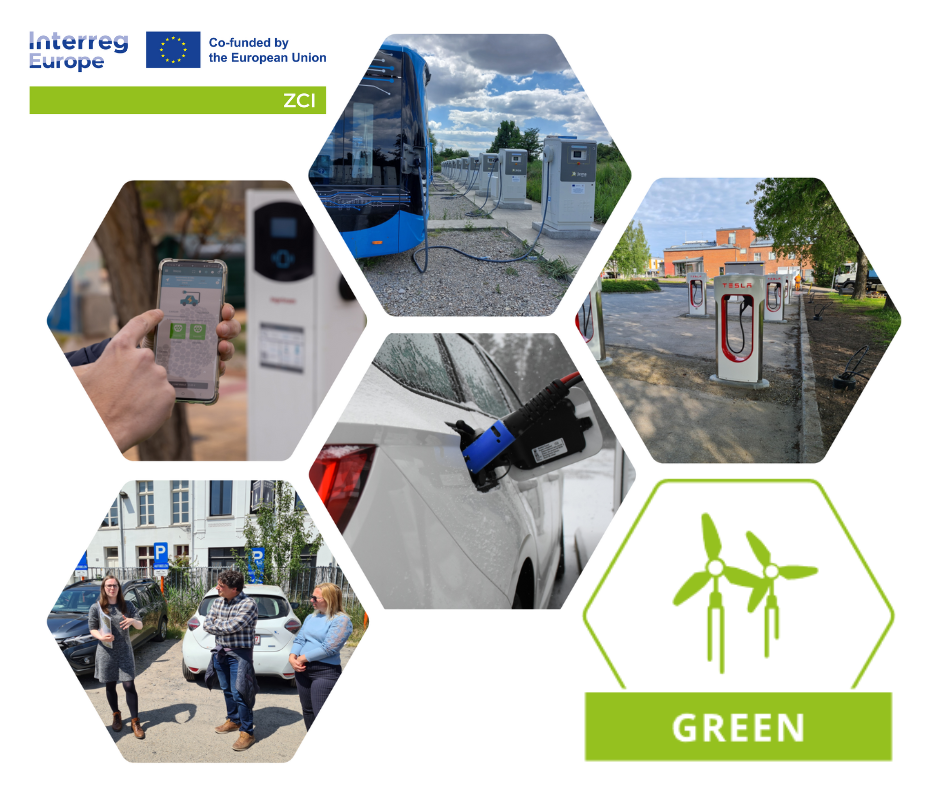The last ZCI project Masterclass will be arranged on 14th – 15th May 2024 in Kainuu, with the theme “Public Acceptance of Electric Vehicles”. Among the project partner regions, Kainuu is a bit different from the others. It might therefore be quite useful to open the topic a bit in advance. Now what does public acceptance of EV’s mean in practice in the northern sparsely populated region of Kainuu in Finland?
From Negative to Positive Structural Change
So, Kainuu is a northern and sparsely populated region with such long distances among houses and population centres that it might even be scary to people coming from densely populated European regions. You may sometimes drive long distances surrounded by forest and without seeing anyone else. This peculiar feeling might surprise even the people born and bred in Kainuu, as returning from a foreign trip and heading home from one of the airports nearby at nighttime. Where on earth is everybody? But, at the same time, oh the sweet peace and silence returning home..
The region has harsh Nordic weather conditions at wintertime. The cold, the dark, all the snow might be hard on your vehicle and on the drivers, as well.
Kainuu region is located far from the capital region, next to the Russian border. Many times, regions like that somehow tend to fall behind. In the past, also this region has suffered from high unemployment rates, out migration, and negative structural change. These days, the region is known for many modern key industries and the regional economy is growing –in fact, the region would need more skilled labour now and relies on attracting immigration.
Renewing Vehicle Stock
As it comes to the vehicle stock, due to the sparse population, long distances and the partly inadequate public transport, the number of vehicles per household is high in the region. On the other hand, the vehicle stock in Kainuu region tends to be from the older side, and in the national comparison on the share of EV’s, the Kainuu region has for years been left behind. The situation has started to change, though.
Looking back to the situation a few years ago, also the EV charging infrastructure in Kainuu has taken a huge leap forward. Especially the bigger retail chains (S Group, K Group) and service station chain of the S Group have made extensive investments around the region. You can find some kind of charging infrastructure from most of those supermarkets, that dominate in the region, these days. You may browse those for example on the site Latauskartta.fi, updated by the national association of EV owners, where you can also see authentic photos.

The Change is On-Going
Electric vehicles have been a rare thing in Kainuu until the recent years. There haven’t been so much either practical information or peer experiences available for the larger public to form a larger movement behind EV’s. Especially the qualities of EV’s and their suitability for the harsh conditions described above have been a bit of a mystery in the public discussion. So, it is no wonder that the share of EV’s hasn’t risen in a region like Kainuu before. However, the Kainuu region seems to be in a serious turning point regarding EV’s now. The amount of both EV’s and charging infrastructure are both steadily growing. Yet there still is a need for sharing information and helping to grow the public acceptance.
Here we also must make a reminder that not everyone has the funds to buy a new car even if they wanted to. The EV’s have also been expensive in comparison to many other vehicles. In fact, the average age of a passenger car in Kainuu (statistics available here) was 15,1 years in 2022. This is more than the national average (12,9 years). The availability of used EV’s, on the other hand, has been lower until the recent days, and probably there hasn’t been enough information to build consumers’ trust to buy a used EV, either.
Looking for authentic experiences and practical real-life examples, the ZCI project didn’t need to go far, though. From the coffee table discussions, we know that both among the ZCI stakeholder group and the staff of Kainuu Regional Council, there are people who have acquired an EV. For this article, we interviewed the staff members of Kainuu Regional Council. How and why did they decide to do so? What have they learned in the process and how do they feel about EV’s now?
According to a quick survey among the 24 employees of Kainuu Regional Council, a significant share of their household cars is either EV’s (4 cars) or hybrids (2) already. In many of the households in question, purchasing an EV in the future is a serious thought, too. As is typical in a region like Kainuu, there might be several cars in one household, so it can’t be generalized that these households have totally transferred to electric mobility, yet it is safe to say that the development tends to be towards electric options. As a background information, there had also been previous several experiences of owning a hybrid car and/ or an electric car among the staff. Overall, there seems to be positive attitude towards EV’s among the staff.
Charging at Home is Typical
Among the staff interviewed, it was a typical solution to charge their car at home at night-time, since this is easy and many times also an affordable solution for a homeowner. Of course, the final price depends on your electricity contract, and lately there have been quite big alterations in the prices that might surprise the households without a fixed price. On the other hand, some nights there had even been a situation where the price was indeed close to negative.
A few of the interviewees also told that they had invested in solar panels in addition to their EV, so that especially at summertime the two investments support each other.
Availability of Public Charging Has Improved
Finding a convenient charging point for your EV may have been a cause of some serious heart throbs in the past years, for example driving in Finnish Lapland, where the distances are even longer than in Kainuu. These days, it’s less and less of a problem, but it still may take some planning to find a fast charger in some remote areas of Northern Finland. In conditions like that, also the battery capacity of your car matters a lot. It might not be worth it to buy a cheaper EV with lower battery capacity, if you live in Northern Finland.
There are several operators that offer charging services in the Kainuu region. ABC lataus, K-Lataus, Tesla Supercharger and Ionity were mentioned by the name to be options for faster charging, with the speed of 100 kwh. There are even more options for slower charging (22 kwh, charging takes some hours), such as the Lidl supermarket chain and Recharge, the largest fast charging network open to everyone in the Nordic countries. The number of operators is a positive thing regarding the general supply, although using multiple apps and standards might at times feel a bit tedious to the customer. However, at least the situation regarding charging standards seems to be slowly improving, as the vehicle stock is renewing.
In Finland, queuing to charging spots doesn’t seem to be a problem yet, either. Among the interviewees, there were only a few experiences when the first charger option selected was broken or already reserved, so that there was a need to seek for another. Even then, it was rather easy to find the next spot and get the car charged at a convenient spot.
There was also experience of international trips among the interviewees. It is quite possible, and getting easier by the day, to travel from Finland to Norway and Sweden with your EV. However, looking at the maps below, you can see that there are development needs related to charging infrastructure in all the three countries that require planning from the traveler’s side. On the international level, the meaning of different payment systems and applications is emphasized even more compared to the national level.

Time and Money – Two Important Factors
It takes some planning to find the most economic option for charging, but it didn’t seem to have a clearly negative effect to the opinions. The charging prices of service providers are set for a few months ahead. During the first months of year 2024, there has been increase in the charging prices of some service providers, causing a significant difference among different options and affecting consumer choices especially on longer trips.
Of course, there are differences among different chargers’ speed, but among the interviewees, there weren’t any real complaints of finding a good solution for the specific needs appearing at a certain moment. On longer road trips, the general experience was that usually the car had been well ready before the driver was set out to continue their trip after a typical lunch or coffee break along the way. One shouldn’t drive for hours without stopping, and the standard break of 15-30 minutes after a 2-3 hours’ drive is quite convenient.
Did it Pay Off?
For most of us, buying a new car may be a big deal and the process may take time and effort. You must know your wants and needs, to find the funding and to compare the multiple options available in the light of facts to make your decision. But if you need a new car, that’s what you must do, right? Being among the vanguards to buy a car with a totally new technology is even more of a consuming process. Will the investment be worth it? What are the actual driving costs? What are the possible dangers and downsides of this new technology? All the what ifs.
If you are interested to transfer to electric mobility, though, there is more and more fact-based information of EV’s and honest consumer experiences available to support your decision. However, on the media, you still frequently bump into click baits or other misleading news of EV’s. How easy it is to read a headline and share false conclusions on social media these days! Healthy media criticism should therefore be practiced.
Electric vehicles might not be the one and only solution to environmental challenges, and some new and improved technologies will one day be available for the consumers again. Battery production for the EV’s has its downsides, as well. However, EV’s will play a big role in the near-term markets, and for a good reason. There’s no need to fear them.
Naming one negative thing, the price bubble of electric cars seems to have burst and the resale value of the vehicles come down quite a bit. If you were among the ones who bought your EV during the first boom with a bigger price and then had to patiently wait for it to arrive as the delivery difficulties hit, this might frustrate you. However, as one has a new car that they’re satisfied with, there’s no hurry to go and change it. And now that the bubble has been burst already, the situation is already different.
For our staff members who have bought an EV, the choice seems to have paid off. They have a new vehicle with new features that they like. Contrary to any possible fears, the operating range of the vehicles has been large enough and is improving in new models. On the other hand, the operating costs have been modest. Living in a small town in Northern Finland, the certified repair shops for this new technology might still be a bit further away than for internal combustion engine cars, but as the cars are new, there hasn’t been much need for repair services yet. On the other hand, the technique of EV’s is quite different from traditional cars and this also seems to affect the amount and quality of the repairs needed in a positive way. In some cases, you can also order a mechanic via your mobile app on your own driveway to do some minor work. Easy, right?


